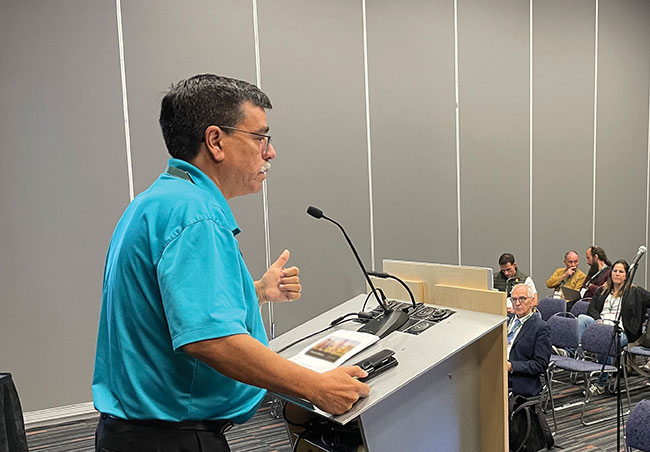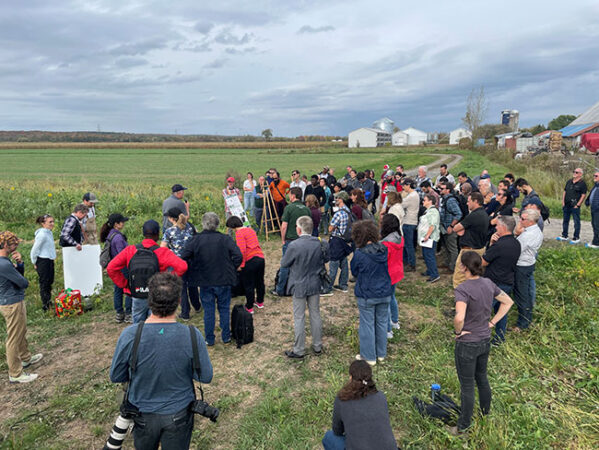
Features
Research
Cultivating innovation
Western Canada’s Living Labs lead the way in agro-ecosystem solutions.
April 10, 2024 By Julienne Isaacs
 Roger Daniels of Mistawasis Nêhiyawak highlights key goals for Bridge to Land Water Sky, the first Indigenous-led Living Lab in AAFC’s nationwide network.
Roger Daniels of Mistawasis Nêhiyawak highlights key goals for Bridge to Land Water Sky, the first Indigenous-led Living Lab in AAFC’s nationwide network. At the first-ever International Forum on Agroecosystem Living Labs held this past October in Montréal, Que., researchers, farmers and industry representatives gathered to discuss lessons learned from Living Labs in Canada and around the world.
The event was co-hosted by Agriculture and Agri-Food Canada (AAFC) and France’s Institut national de recherche pour l’agriculture, l’alimentation et l’environnement (INRAE). Speakers from countries including Belgium, Greece, Germany, Uruguay and the United States shared insights from research projects and experiences in their respective regions.
The Living Labs concept, originally developed by MIT as a user-centred, open innovation model for research in information technology, has three core principles, says François Chrétien, director of Living Labs, Agroclimate, Geomatics and Earth Observation Division and Saint-Jean-sur-Richelieu Research and Development Centre at AAFC.
“The first is user-centred innovation, which means the user – it could be a citizen, [but] for us it’s the agricultural producer – is involved throughout the innovation approach, not just consulted at the beginning of the project,” he says.
The second principle is that projects take a multi-partner approach to tackling common problems. And the third is the “real-life experimental setup,” Chrétien says. “The scientists work on real farms with real producers. This creates challenges with scientific research – there’s a lot more variability. [But] when you put the three principles together, you really have the added value of the living lab.”
Chrétien has been involved in AAFC’s Living Labs programs since the beginning and helped present the concept to the G20 in 2018 – the first time the Living Labs model had been applied in this way in an agricultural context. At the G20, an international working group was formed, with France and the European Union emerging as key collaborators with AAFC, says Chrétien. Recently, the EU has launched an initiative to establish 100 Living Labs focused on soil health across Europe, building on the lessons learned in Canada.
“We’ve seen such a rapid increase in the use of the approach, and attention on the approach internationally. We’ve been out ahead in its application,” he adds. “Even before 2018, we had an internal conversation at AAFC that we needed to address agro-ecological challenges in a different way – we needed to break down the silos between the natural and social sciences and reconnect with the producer.”
In Canada, nine new Living Labs – six of them in Western Canada – were announced last year, adding to the four existing Living Labs launched in 2018.
“Across our network of Living Labs, each one is applying a common approach using common objectives,” explains Chris McPhee, associate director of Living Labs for AAFC. “But each of those Living Labs is quite unique in terms of what it does within that framework.”

Participants went on a field tour of a Living Lab site in Ferme Cristallina, Que., where they saw innovative practices co-developed and tested right on the farm.
Western Canadian Living Labs
The new Living Labs announced in 2022 include one in B.C., one in the Peace Region of B.C. and Alberta, an Alberta Beef Producers-led project in Alberta, a province-wide Living Lab in Alberta, a First Nations-led project with partners Mistawasis Nêhiyawakand Muskeg Lake Cree Nation in Saskatchewan and a Central Prairies project in Saskatchewan.
The British Columbia project is led by the B.C. Investment Agriculture Foundation (IAF) and will look at six new beneficial management practices for farming that will help mitigate the effects of climate change. The Peace Region project, led by the Peace Region Forage Seed Association, has a similar approach – it’ll look at the impacts of applying BMPs on land management, economics and social elements on a whole-farm level.
The Alberta Beef project will examine the use of beef, forage and cropping systems to improve soil carbon sequestration and reduce greenhouse gas emissions, while the province-wide Regenerative Alberta Living Lab will aim to study the use of regenerative practices across the province.
The southern Saskatchewan Living Lab, led by South of the Divide Conservation Action Program, will examine four key areas: avoiding land use conversion; adaptive grazing management; restoring and enhancing perennial plant communities; and livestock grazing of diverse annual cover crops.
The Bridge to Land Water Sky Living Lab, led by Mistawasis Nêhiyawak and Muskeg Lake Cree Nation, is history-making: it’s the initial First Nations-led Living Lab in Canada. McPhee says the project will have five key goals.
“One is improving land management strategies for the mitigation of greenhouse gas emissions and to improve carbon sequestration,” he says. “They’re also looking at increasing food sovereignty and food security and protecting biodiversity and water. There’s also an emphasis on creating employment and learning opportunities for youth and communities and a focus on re-imagining Indigenous landowner and producer relationships. Not just within their context, [but] strengthening partnerships with other groups in the Living Labs.”
McPhee says that different Living Labs operate on varying scales and in different ways, and this diversity is a real strength.
“We see a great diversity in the Living Labs, which reflects the diversity of agriculture across Western Canada,” he says. “That’s a key message – these are place-based projects, and although they all have common goals, they’re reflecting the needs of agriculture in those places. The Living Labs are engines of innovation to come up with solutions that address producers’ needs.”
There is a very zoomed-out international layer to the Living Labs approach for Canada, on top of the national and regional layers. But its chief goal is to centre on the needs and efforts of producers.
“Ultimately, we’re trying to reach a broad-scale adoption of practices that will make a difference,” says McPhee. “That kind of adoption comes from sharing with other producers. These Living Labs have a lot of knowledge exchange. Reaching out to the broader community of producers will be essential to the process.”